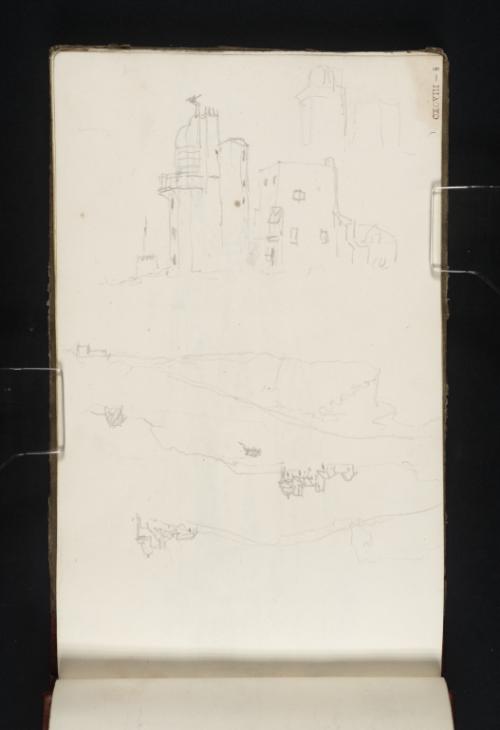Joseph Mallord William Turner ?South Foreland Lighthouse c.1821-2
Image 1 of 2
Joseph Mallord William Turner,
?South Foreland Lighthouse
c.1821-2
Joseph Mallord William Turner 1775–1851
Folio 8 Recto:
?South Foreland Lighthouse c.1821–2
D17220
Turner Bequest CXCVIII 8
Turner Bequest CXCVIII 8
Pencil on white wove paper, 187 x 113 mm
Stamped in black ‘CXCVIII – 8’, top right, ascending vertically
Stamped in black ‘CXCVIII – 8’, top right, ascending vertically
Accepted by the nation as part of the Turner Bequest 1856
References
1909
A.J. Finberg, A Complete Inventory of the Drawings of the Turner Bequest, London 1909, vol.I, p.604, CXCVIII 8, as ‘A lighthouse on cliff (? South Foreland)’.
1998
James Hamilton, Turner and the Scientists, exhibition catalogue, Tate Gallery, London 1998, pp.91, 133 note 22.
Made with the page turned vertically, the topmost drawings describe a stout lighthouse with adjoining cubic building featuring corner detailing and a flat roof. In the top right corner a brief outline entertains the topic, and then a more developed study records it in detail beneath, stretching across the whole breadth of the page.
Finberg includes in his title for this page the suggestion that the scene is taken at South Foreland, a chalk headland on the Dover coast.1 The lighthouse currently stationed there bears no resemblance to the present drawing, but is the result of extensive rebuilding. Since the fourteenth century there have been warning lights positioned on the White Cliffs at South Foreland, which overlook the hazardous Goodwin Sands. In 1367 Brother Nicholas de Legh first hung a lantern on the cliff face to warn sailors of the danger.2
The earliest lighthouses were constructed at the site in 1635. Sir John Meldrum oversaw the installation of two iron braziers which each held an open fire. These became known as the Upper and Lower lighthouses. In 1793 John Yenn redesigned the Upper Lighthouse using oil lamps. Two years later the Lower Light was rebuilt to a similar design but across only two floors, as compared to the taller, three-floored Upper Light.3 This is the point at which Turner would have encountered the lighthouses at South Foreland. For further studies of this landmark in the present sketchbook, see folios 8 recto, 10 verso, 15 recto, 35 verso, 63 verso, 67 verso, 69 recto–70 recto, 77 verso, and 79 recto (D17220, D17225, D17231, D17267, D17313, D17321, D17324–D17326, D17338, D17341). A distant outline of the same lighthouse is also described on a page of the France and Folkestone sketchbook of about 1826 (Tate D24132; Turner Bequest CCLVI 13a).
An early monochromatic pencil and wash study by Turner entitled North Foreland Lighthouse, Kent dating from around 1793–5 (private collection) describes identical architectural forms to those depicted on the present page.4 North Foreland lighthouse stands on the chalk headland above Broadstairs, on the north-eastern coast of Kent.5 A light was first stationed at the site in 1499, replaced by a lighthouse in 1636. When two additional levels were added to the tower in the 1790s, eighteen oil lamps were also installed to replace the coal fire.6 Turner made several sketches of this structure. They can be found in the Studies near Brighton sketchbook (Tate D00770; Turner Bequest XXX 35), and the Gravesend and Margate sketchbook (Tate D27328 and D27329; Turner Bequest CCLXXIX 33a and CCLXXIX 34). What seems clear from these drawings is the striking difference between the structure delineated as the North Foreland lighthouse, and the subject of the North Foreland Lighthouse, Kent watercolour. Possibly the latter has been misidentified. On the basis of the evidence in other sketchbooks within the Turner Bequest, it seems unlikely that the present page describes North Foreland.
Between 1807 and 1811 Bell Rock lighthouse was built to Robert Stevenson’s designs off the Angus coast, south-west of Arbroath in Scotland.7 It was a revolutionary feat of engineering, and in 1819 Turner produced a spectacular watercolour for the frontispiece of Stevenson’s account of its construction (National Gallery of Scotland, Edinburgh).8 James Hamilton has suggested that this commission ignited in Turner a more acute and consistently demonstrable interest in lighthouses.9 He cites the Folkestone sketchbook as evidence of this, noting that it includes several particularly attentive drawings of such landmarks.10
Across the centre of the page is a drawing which appears to describe further coastal topography, with an architectural structure indicated on the far left.
On the bottom half of the page, with the sketchbook turned vertically in the opposite direction, Turner notes two impressions of a coastal landscape. Each seems to describe a distant view from inland of a sea-facing cliff, on which perches the South Foreland lighthouse in both instances.
Sketches which describe the topography at South Foreland, but not the lighthouse itself, can be found on folios 34 verso, 35 recto, 70 verso, and 71 recto (D17265–D17266, D17327–D17328).
Maud Whatley
January 2016
‘The History of the Lighthouse’, South Foreland Lighthouse, accessed 30 October 2015, http://www.nationaltrust.org.uk/south-foreland-lighthouse/features/the-history-of-the-lighthouse .
See Charles Miller Ltd, ‘Lot 17’, Auction Catalogue, November 2015, p.8, accessed 30 October 2015, http://www.charlesmillerltd.com/Catalogues/ms031115/lot0017.html .
‘North Foreland Lighthouse’, Trinity House, accessed 30 October 2015, http://www.trinityhouse.co.uk/lighthouses/lighthouse_list/north_foreland.html .
‘Bell Rock Lighthouse’, National Galleries Scotland, accessed 17 October 2015, https://www.nationalgalleries.org/collection/artists-a-z/t/artist/joseph-mallord-william-turner/object/bell-rock-lighthouse-d-5181-a .
How to cite
Maud Whatley, ‘?South Foreland Lighthouse c.1821–2 by Joseph Mallord William Turner’, catalogue entry, January 2016, in David Blayney Brown (ed.), J.M.W. Turner: Sketchbooks, Drawings and Watercolours, Tate Research Publication, February 2017, https://www


